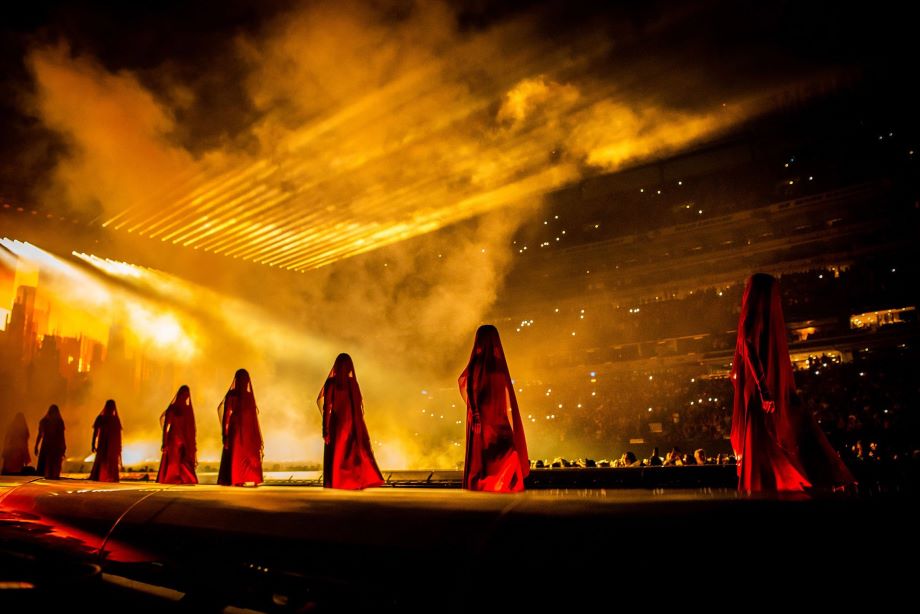
Major concerts aren’t just about sound; they’re about sight too. From The Weeknd’s skyline-themed sets to Arcade Fire’s suburban overpass imagery, Canadian artists performing in New York have turned venues into immersive worlds. Much of this transformation comes from smart use of backdrop printing NYC, which allows musicians to project their brand, themes, and storytelling directly onto the stage. This roundup highlights standout live shows where Canadian acts used stunning backdrops and stage design to make their New York performances unforgettable.
1) The Weeknd — After Hours Til Dawn (MetLife Stadium / NYC-area)
What the stage/backdrop did: a towering city-skyline motif and dramatic lighting sequences tied to the album’s nocturnal themes; long runways and suspended scenic elements extended the visual world into the crowd.
Why it amplified the show: printed scenic elements + dynamic lighting created a cinematic, album-specific environment rather than a generic stage, reinforcing The Weeknd’s aesthetic and narrative.
2) Drake — Aubrey & The Three Amigos (Madison Square Garden residency)
What the stage/backdrop did: jaw-dropping stage architecture (notably the giant scorpion centerpiece during the MSG run), large LED surfaces and custom scenic structures.
Why it amplified the show: bold, instantly memorable props and wraparound visuals create branding moments that turn set pieces into social-media icons — they don’t just support the music, they become the show.
3) Arcade Fire — The Suburbs era (Madison Square Garden + arena runs)
What the stage/backdrop did: large printed backdrops and projection surfaces evoking suburban motifs (overpasses, billboards, highways), often combined with projection mapping.
Why it amplified the show: the printed backdrop establishes the core mise-en-scène (the “world” of the record); layered lighting and video turn that static frame into a living, shifting stage set.
4) Shawn Mendes — The Tour / 2019 (MSG and U.S. arenas)
What the stage/backdrop did: a prominent circular LED/visual screen behind the performer with flowing, watercolor and nature-inspired video content that matched each song’s mood.
Why it amplified the show: the single bold screen acts like a theatrical backdrop — it’s both a visual anchor and a storytelling device that moves the audience emotionally through the set.
5) Justin Bieber — My World / Purpose era (Madison Square Garden + arenas)
What the stage/backdrop did: large LED walls and printed scenic pieces used during arena runs to create intimate and massive moments alternately.
Why it amplified the show: switching from sparse sets (for ballads) to full scenic/LED floods (for pop hits) shapes audience energy and reinforces the artist’s brand across moods.
6) Céline Dion — Arena residencies and NYC appearances (MSG and other large venues)
What the stage/backdrop did: grand, theatrical set pieces and scenic lighting that frame her voice with cinematic imagery — often large projection or LED replacement backdrops.
Why it amplified the show: the visuals are designed to echo the emotional sweep of the songs; on big stages, printed/scenic backdrops help maintain intimacy by providing clear visual focus.
7) Rush — R40 / Moving Pictures (Madison Square Garden shows)
What the stage/backdrop did: rock-stadium scale scenic elements, album-referencing visuals and large screen backdrops during the R40 anniversary run.
Why it amplified the show: for legacy acts, backdrop design ties decades of catalog into a coherent live narrative — it’s both nostalgia and spectacle.
8) Barenaked Ladies — MSG and NYC arenas
What the stage/backdrop did: lively scenic and lighting design for arena dates; printed elements and projections used to punctuate comedic and high-energy moments.
Why it amplified the show: a versatile backdrop lets a band toggle between intimate comedy banter and arena-scale singalongs without losing the show’s personality.
9) Metric / Feist / other Canadian indie acts — NYC club & theatre runs
What the stage/backdrop did: smaller printed banners, textured backdrops, and creative projection work more common at theatres and clubs.
Why it amplified the show: printed or fabric backdrops in smaller venues allow indie acts to project a clear visual identity without huge budgets — a well-designed backdrop elevates a tight live set into a branded experience.
10) Festival appearances (Governors Ball, Panorama) — Canadian headliners
What the stage/backdrop did: festival billboards, festival-wide stage graphics, and LED walls that are often customized per headliner.
Why it amplified the show: at multi-artist festivals, custom backdrops (or tailored video content) help artists carve out a distinct visual identity on a shared stage, making them stand out in festival memory and photos.
Final Thoughts
These concerts show how much a stage can transform when visuals work hand in hand with the music. Canadian artists in New York aren’t just performing songs; they’re creating full sensory experiences that stay with fans long after the encore. With the right creative team and tools like backdrop printing NYC, even a plain arena or theater can become a canvas for storytelling, branding, and atmosphere. It’s a reminder that a well-designed backdrop isn’t just decoration, it’s part of the performance itself. Artists looking for other low-cost ways to raise their profile can also check out our guide on Directory Listings 101: How Indie Artists Can Gain More Exposure.
